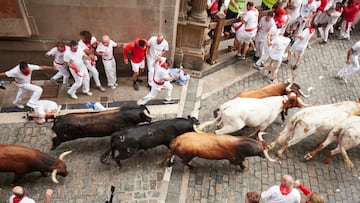Running with the bulls in Pamplona: All you need to know about watching and participating
You don’t need a lot of money to run with the bulls in Pamplona, but you will need a lot of courage to enter the 848-meter stretch of streets where the “encierro” takes place every day from July 7 to July 14.


What you do need to run with the bulls is to be a little crazy and/or very brave because running alongside 1,000+ pound bulls is not for the faint of heart. They are big and fast, which is why the experienced runners choose their stretch of street very carefully to have their 100 meters of glory alongside those amazing animals.
Running with the bulls is free and so is watching it. Don’t expect to find grandstands or perfect views at street level, because the entire path is barricaded to make sure the bulls end up in the bull ring at the end of the run. RTVE, Spanish public television, broadcasts the event live every day at 8 a.m. Spain time (2 a.m. ET in the U.S.). They also stream the running of the bulls on YouTube so you can watch it live from anywhere in the world or watch the action later in the day.
Getting a good seat in Pamplona
For those lucky enough to be in Pamplona for the festivities, you should try to find a good vantage point at one of the seven main points on the street.
- Santo Domingo - The uphill street where the bulls leave the pen at 8 a.m. sharp.
- City Hall - This section is fenced off, which allows runners to go over or under for safety.
- Mercaders street - There is a dangerous turn at the end of this street. Avoid the left hand side.
- Estefeta street - A long, straight sprint in a dangerous stretch where bulls sometimes get separated from the pack.
- Telefonica - A dangerous area where speed picks up again as the street slightly lowers to the bull ring entrance.
- The alley - This is the last section before entering the bullring and this part narrows fast causing runners to get stuck, hit or run over.
- The bullring - The end of the line, but danger is still present as bulls are loose in the ring. Don’t celebrate too early.
Some sports are just better on TV and, although running with the bulls wouldn’t be considered a sport by most, it is fast and requires runners to be in excellent physical condition. The bulls and runners sprint past the onlookers and after waiting for hours to see the excitement, many visitors are disappointed to see everyone fly by them in just a few seconds.
If money isn’t an issue, one of the best vantage points is from one of the apartment balconies that overlook the street. Prices go anywhere from $100 - $250 per person for one hour including breakfast. It isn’t cheap, but it is a great way to see the action from a safe distance.
Running with the bulls
Rules must be followed when participating in this annual event. The police do not allow people who have been drinking to participate in the “encierro.” If you are allowed to enter, you could get fined for running and taking photos or video. Every day at the end of the sprint, the local authorities tell the broadcasters how many people have been injured and on average 4-5 runners spend some time in the local hospital.
Hiding is not an option. The bulls have been known to turn around and find runners who are doing their best to avoid trouble. It is highly recommended to watch “encierros” from previous years to have an idea where and when to run. Appropriate clothing (traditional white pants and shirt) and footwear is also important because you will be running at full speed.
Ernest Hemingway’s first visit to Pamplona was 100 years ago, which he repeated the following four years and then again in 1929. His novel “The Sun Also Rises” is based on his first trip from Paris to Pamplona and his fascination with the running of the bulls and bullfights. The Sanfermin festival wouldn’t be what it is today if it hadn’t been for Hemingway and his love of Spain.





